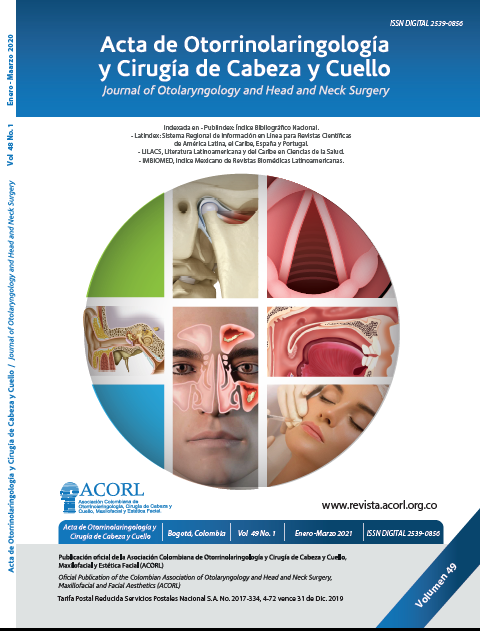Complicaciones posquirúrgicas del manejo del dorso nasal con la técnica cartílago en puente
Contenido principal del artículo
Resumen
una nueva técnica de injerto dorsal denominada cartílago en puente (CEP),
realizada en rinoplastias cerradas por un solo otorrinolaringólogo. No obstante, no
existen estudios que caractericen las complicaciones de esta técnica. Objetivo del
estudio: caracterizar las complicaciones posquirúrgicas del manejo del dorso nasal
con CEP en pacientes sometidos a una rinoplastia. Metodología: estudio observacional
descriptivo, de corte transversal y de carácter retrospectivo, que abarca los
registros clínicos de pacientes sometidos a una rinoplastia cerrada con la técnica
CEP entre 2013 y 2016. Se midieron variables sociodemográficas, características del
procedimiento y se registraron las complicaciones detectadas durante el seguimiento
posoperatorio: aparición de infección, extrusión, desplazamiento y reabsorción del
injerto Resultados: se identificaron 882 historias clínicas. La mediana de edad fue
de 28 años, siendo el 81 % del género femenino. La rinoplastia fue primaria en 80,6
%, el material del injerto dorsal fue solo cartílago en 80,6 %, Gore-Tex® en 1,7 %
y una combinación de cartílago y Gore-Tex® en 17,7 %. La mediana de duración de las rinoplastias fue de 78 minutos (rango intercuartílico [RIC]: 72-85), siendo el
principal procedimiento adicional la septoplastia en 82,2 %. El 18,2 % de los pacientes
presentaron complicaciones. El desplazamiento fue la principal complicación
reportada (14,7%), seguida de la reabsorción (4,0 %) e infección (0,1 %). Conclusiones:
la técnica CEP mostró como principales complicaciones el desplazamiento y
la reabsorción del injerto, con una frecuencia similar a la descrita en otros estudios.
Detalles del artículo
Sección

Esta obra está bajo una licencia internacional Creative Commons Atribución-CompartirIgual 4.0.
Este artículo es publicado por la Revista Acta de Otorrinolaringología & Cirugía de Cabeza y Cuello.
Este es un artículo de acceso abierto, distribuido bajo los términos de la LicenciaCreativeCommons Atribución-CompartirIgual 4.0 Internacional.( http://creativecommons.org/licenses/by-sa/4.0/), que permite el uso no comercial, distribución y reproducción en cualquier medio, siempre que la obra original sea debidamente citada.
eISSN: 2539-0856
ISSN: 0120-8411
Cómo citar
Referencias
Niamtu J. Cosmetic Facial Surgery. 2.a edición. [San Luis]: Elsevier; 2018. 808 p.
Bagheri SC. Primary Cosmetic Rhinoplasty. Oral Maxillofac Surg Clin North Am. 2012;24(1):39-48. doi: 10.1016/j.
coms.2011.10.001
Noemi LP. Cirugía estética de nariz. Rev Actual Clínica.2014;47:2514-9.
Constantian MB. Rhinoplasty: Craft and Magic. 1.a edición.Nueva York: Thieme; 2009. 2302 p.
López-Cedrun JL. Cirugía reconstructiva y estética del tercio medio facial. 1.a edición. [Madrid]: Editorial ARAN; 2005. 366p.
Fonseca R. Oral and Maxillofacial Surgery. 3.a edición. San Luis: Elsevier Saunders; 2017. 2696 p.
Adamson PA, Galli SK. Rhinoplasty approaches: current state of the art. Arch Facial Plast Surg. 2005;7(1):32-7. doi: 10.1001/archfaci.7.1.32
Abarca AA, Naser GA, Pardo JJ. Aplicaciones de materiales aloplásticos en rinoplastía. Rev. Otorrinolaringol. Cir.
Cabeza Cuello. 2010;70(3):259-64. doi: 10.4067/S0718-48162010000300010
Sajjadian A, Rubinstein R, Naghshineh N. Current status of grafts and implants in rhinoplasty: part I. Autologous grafts.
Plast Reconstr Surg. 2010;125(2):40e-49e. doi: 10.1097/PRS.0b013e3181c82f12
Sajjadian A, Naghshineh N, Rubinstein R. Current status of grafts and implants in rhinoplasty: Part II. Homologous grafts and allogenic implants. Plast Reconstr Surg. 2010;125(3):99e-109e.doi: 10.1097/PRS.0b013e3181cb662f
Escobar Sanz-Dranguet P, Márquez Dorsch F, Villacampa Aubá JM, Sanabria Brassart J, Gutiérrez Fonseca R, Pastormerlo Botegia G, et al. Injertos cartilaginosos en rinoplastia. Acta Otorrinolaringol Esp. 2002;53(10):736-40.
Gunter JP RR. Augmentation rhinoplasty: dorsal onlay grafting using shaped autogenous septal cartilage. Plast Reconstr Surg. 1990;86(1):39-45.
Álvarez-Buylla Blanco M, Sarandeses García A, Chao Vieites J, Babarro Fernández R, Deus Abelenda C, Padín Seara A.
Resultados funcionales y estéticos tras rinoplastia de aumento.Acta Otorrinolaringol Esp. 2011;62(5):347-54.
Lin G, Lawson W. Complications using grafts and implants in rhinoplasty. Oper Tech Otolaryngol - Head Neck Surg.
;18(4):315-23. doi: 10.1016/j.otot.2007.09.004
Moretti MP, Casari L. Satisfacción y motivación de la cirugía estética en mujeres y su relación con los esquemas
desadaptativos tempranos. Psicogente. 2017;20(38):222-39.doi: 10.17081/psico.20.38.2543
Godfrey NV. Augmentation rhinoplasty with mortised septal cartilage. Aesthetic Plast Surg. 1993;17(1):31-5. doi: 10.1007/BF00455046
Godin MS, Waldman SR, Johnson CM Jr. Nasal augmentation using Gore-Tex. A 10-year experience. Arch Facial Plast
Surg. 1999;1(2):118-21; discussion 122. doi: 10.1001/archfaci.1.2.118
Lohuis PJ, Watts SJ, Vuyk HD. Augmentation of the nasal dorsum using Gore-Tex: intermediate results of a retrospective
analysis of experience in 66 patients. Clin Otolaryngol Allied Sci. 2001;26(3):214-7. doi: 10.1046/j.1365-2273.2001.00453.x
Bracaglia R, Fortunato R, Gentileschi S. Secondary rhinoplasty. Aesthetic Plast Surg. 2005;29(4):230-9. doi: 10.1007/s00266-005-0034-z
Mao J, Carron M, Tomovic S, Narasimhan K, Allen S, Mathog RH. Cartilage grafts in dorsal nasal augmentation of traumatic saddle nose deformity: a long-term follow-up. Laryngoscope. 2009;119(11):2111-7. doi: 10.1002/lary.20491





